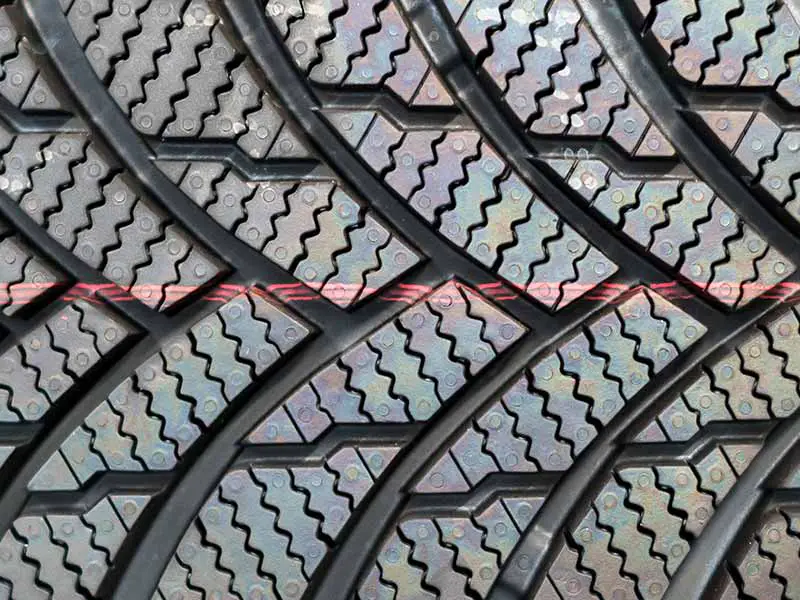Replacing tires can hit the wallet hard, and there’s a set that’s the right size but much more affordable than your current brand. It’s tempting to just swap out the worn ones and save some cash. If you’re wrestling with the decision of whether to mix tire brands to cut costs, you’re not alone.
Do My Front Tires Have To Match The Rear?
Front and rear tires should generally match in size and intended use to ensure proper vehicle handling and safety, although they do not necessarily need to be from the same brand.
What’s important is to maintain the same tire size and type of tire.
In this article, we’ll explore the intricacies of tire matching, the impact of different tread patterns, sizes, and brands on your car’s performance, and why experts lean towards recommending matching tires for both the front and rear.

The Role of Tires in Vehicle Dynamics
When we talk about how a car moves and handles on the road, tires play a crucial role. They are the only part of the car that touches the road, and they work hard to keep the car stable, especially when it turns, stops, or accelerates. If the tires on a car are not well-matched, it can lead to problems. Let me explain why it’s important to keep your tires in sync.
Stability and Balance
Imagine walking with one shoe on and one shoe off; it feels awkward, right? That’s similar to what happens when a car has mismatched tires. Each tire has a job to do:
- Front Tires: These steer the car. They turn left or right when you move the steering wheel.
- Rear Tires: These tires support the back of the car and help keep the car stable.
If the front and rear tires are not the same, the car might not handle the way it should. For example, if the rear tires are worn out more than the front tires, the car might slide sideways in a sharp turn. This is because the worn tires don’t grip the road as well as the newer ones.
Tread Wear and Tire Life
Tires wear down as they roll on the road. This wear can happen unevenly if:
- The car’s alignment is off.
- The tires are not rotated regularly.
- The car is driven hard, like fast starts or hard stops.
I’ve seen many cars come into my shop with tires that are worn down on one side more than the other. This can cause the car to pull to one side and can even lead to a tire blowout if not fixed. It’s important to check your tire tread depth regularly. You can learn more about tire tread depth and why it matters on our page about AWD tire replacement myths.
The Importance of Matching Tires
When you have the same tires on all four wheels, the car is balanced. This balance helps with:
- Handling: The car will steer and turn smoothly.
- Braking: The car will stop in a straight line when you hit the brakes.
- Fuel Economy: Well-matched tires can help your car use less gas.
If you’re driving a car with an all-wheel-drive (AWD) or four-wheel-drive (4WD) system, having the same tires is even more important. These systems work best when all four tires are identical in size, wear, and tread pattern. If they’re not, it can put extra stress on the car’s drivetrain. You can read about the differences between AWD and 4WD on our page that explains the difference between all-wheel drive and 4-wheel drive.
When to Replace Tires
It’s best to replace all four tires at the same time. But if you need to replace just one or two because of damage or wear, make sure the new tires are the same brand, size, and type as the ones already on the car. If you’re not sure whether to put new tires on the front or back, our guide on where to put new tires can help you decide.

nakhon100, CC BY 2.0, via Wikimedia Commons
Front vs. Rear Tires – Can They Be Different?
When it comes to your car’s tires, you might wonder if it’s okay to mix and match. Let’s dive into whether your front and rear tires can be different and what that means for your car.
Matching Tires for Safety and Performance
Your car’s manufacturer chose specific tires because they offer the best balance for your car’s safety and performance. Here’s why matching is important:
- Grip: Tires with the same tread design grip the road in a consistent way. This is crucial when you need to stop quickly or if you’re driving on slippery roads.
- Wear: If all tires are the same, they tend to wear evenly. This means you won’t have one tire that’s more worn than the others, which can cause handling problems.
The Issue with Different Rolling Diameters
The rolling diameter of a tire is how big it is when it rolls. If the front and rear tires have different rolling diameters, it can cause issues:
- Odometer and Speedometer Errors: Your car’s computer thinks all tires are the same size. If they’re not, it can give you the wrong speed or distance traveled.
- Drivetrain Stress: Cars with AWD or 4WD systems can be damaged if the tires are different sizes. The system tries to make all wheels turn the same, but if the tires are different sizes, it can’t do that properly.
If you’re considering running different size tires on the rear axle, make sure to read our detailed explanation on the implications of running different size tires on the rear axle.
Can You Mix Tire Brands?
Sometimes you might not be able to find the same brand of tire that’s already on your car, or maybe you find a good deal on a different brand. Here’s what I suggest:
- Check the Specifications: Make sure the size, load index, and speed rating match your current tires.
- Consult a Professional: A tire expert can tell you if the tires you’re considering will work well with your car.
Mixing tire brands isn’t ideal, but it can be done safely if you take the time to ensure the specifications match.
What About Different Tires on the Same Axle?
It’s not recommended to have two different tires on the same axle. Here’s why:
- Uneven Wear: One tire could wear out faster than the other, which can lead to poor handling.
- Handling Issues: Your car might pull to one side or handle unpredictably, especially in wet conditions.

The Consequences of Mismatched Tires on Different Drivetrains
When you’re driving, the type of drivetrain your vehicle has plays a big part in how it handles the road. Let’s talk about what could happen if you have mismatched tires on different kinds of drivetrains.
Mismatched Tires on Front-Wheel Drive (FWD) Vehicles
FWD cars have the engine power sent to the front wheels. This means the front tires do most of the work for moving and steering. Here’s what to keep in mind:
- Steering and Traction: If the front and rear tires are different, you might notice the car doesn’t steer as smoothly or the rear of the car doesn’t follow the front as it should.
- Tire Wear: The front tires on an FWD car will wear out faster than the rear. It’s important to rotate them regularly to help them wear evenly.
Different Tires on All-Wheel Drive (AWD) Vehicles
AWD vehicles are a bit more complex. They send power to all four tires to optimize traction. Here’s why matching is crucial:
- Drivetrain Damage: AWD systems are sensitive to differences in tire size. If the tires don’t match, it can cause extra wear on the drivetrain components, leading to expensive repairs.
- Handling: For the best grip and performance, especially in bad weather, you need all four tires to be the same.
For those interested in the technical aspects of AWD systems and how they differ from 4WD, you can find more information on our page about the difference between all-wheel drive and four-wheel drive.
Mismatched Tires on Four-Wheel Drive (4WD) Vehicles
4WD vehicles are often used for off-roading or tough road conditions. Here’s what happens if the tires don’t match:
- Reduced Off-Road Capability: If the tires are different, you might find that the vehicle doesn’t handle off-road conditions as well as it should.
- Increased Wear on Components: Just like with AWD, mismatched tires can put a strain on the 4WD system, causing parts to wear out sooner.
Mismatched Tires on 4×4 Vehicles
Vehicles with a 4×4 drivetrain are designed to handle rugged terrain. Using two different size tires on the front and rear can lead to:
- Handling Problems: The vehicle might not respond well when you steer, which can be dangerous on challenging terrains.
- Transmission Stress: The transmission is designed to work with tires of the same size. Different sizes can cause damage over time.
In my experience, I’ve seen the importance of matching tires on vehicles with sophisticated drivetrains like AWD and 4WD. It’s not just about the immediate handling issues — mismatched tires can lead to long-term damage that costs a lot to fix.
This issue can easily be overblown since there can be quite a lot of variation in tire size without causing problems, but more extreme differences can be a problem.
I always advise drivers to stick with the same type and size of tire that their vehicle came with. It’s the best way to ensure that all the complex parts in the drivetrain work together as they’re supposed to.
Tire Size and Width Considerations
When you’re picking out tires for your car or truck, the size and width of the tires are more important than you might think. Let’s go over what you need to know about tire size and width, and why it’s best to keep them consistent.
The Importance of Tire Size
Every car is designed with a specific tire size in mind. This size affects:
- How the Car Handles: The size of your tires affects how your car accelerates, brakes, and turns.
- The Space in Your Wheel Well: There’s only so much room where your tires fit. If the tire is too big, it might rub against the car when you turn or go over bumps.
Why Tire Width Matters
The width of your tire is the part that touches the road. It’s important because:
- Wider Tires: They can give you more grip, but they can also make your car use more gas and might not fit properly.
- Narrower Tires: They’re better in snow and rain because they can cut through to the road better, but they might not handle as well in dry conditions.
Running Different Size Tires on the Rear Axle
Some people think about putting bigger tires on the back of their car or truck for a different look or maybe for better traction. But this can cause problems:
- Handling: Your car might not handle the way it’s supposed to, which can make driving safely harder.
- Wear on the Car: Parts of your car, like the suspension and brakes, might wear out faster because they’re not designed for different size tires.
If you’re curious about the effects of different tire sizes on the rear axle, we’ve got a detailed article that covers everything you need to know here.
Resources
Below are some links you may find helpful when learning about tires:
Final Thoughts
Throughout this article, we’ve delved into the various aspects of tire compatibility and the potential risks of mismatched tires.
From the importance of identical tread patterns for handling to the implications of different tire sizes on drivetrain health, it’s clear that while your car can operate with non-matching tires, uniformity is key to maintaining optimal performance and safety.
The bottom line though is that as long as you use the same size tires that are designed for the same purpose, you shouldn’t have any problems.
Good luck and happy motoring.




